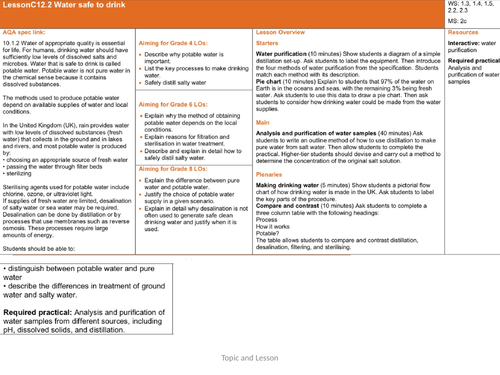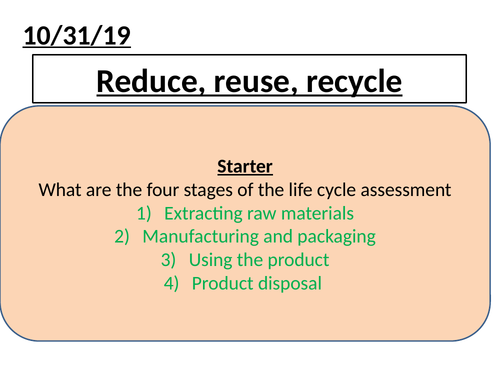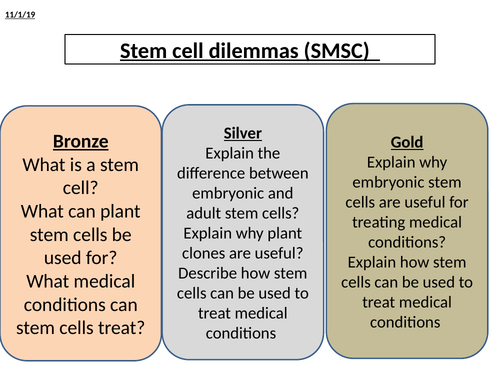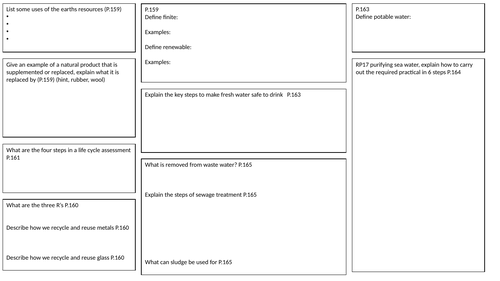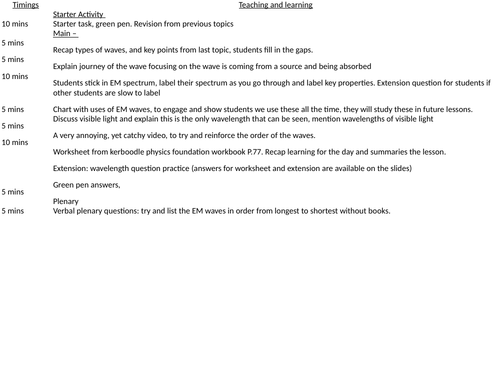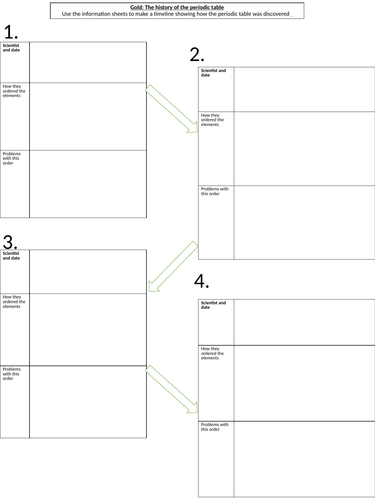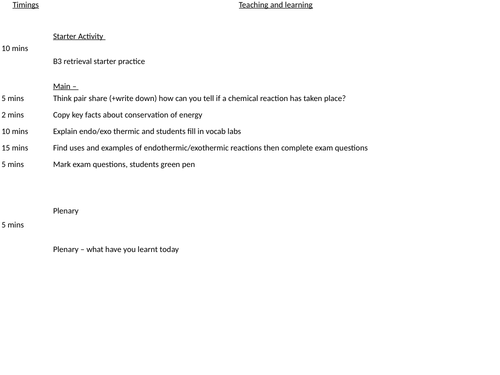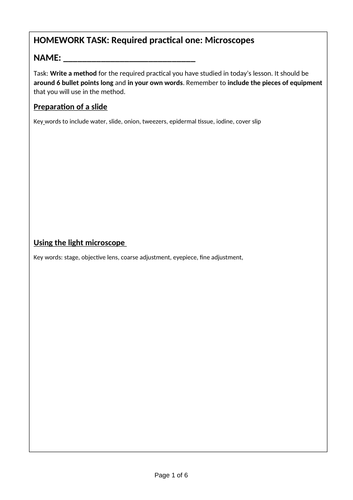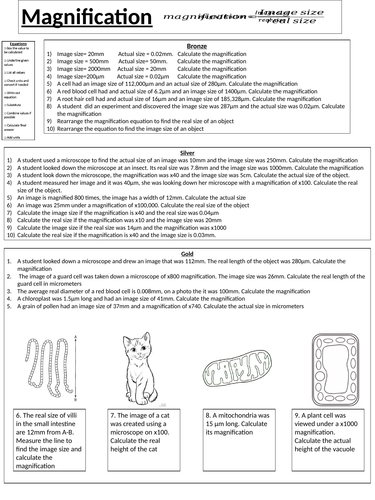
123Uploads
27k+Views
8k+Downloads
All resources

Potable water differentiated worksheet
Bronze/silver/gold differentiated worksheets
To show how potable water is made
Aimed at low ability students

C12.1 Making water safe to drink
Starter: differentiated starter questions with answers
Main: Discussion which water from the pictures would you rather drink.
Define: potable water
Carry out required practical
answer questions
green pen, self assess questions
discuss why water is so important.
Complete worksheet to show how potable water is made (differentiated worksheets)

C12. treating waste water
For low ability students. targets level 4
Starter: differentiated stater based on prior learning of the topic
answers on following slide
Main: think pair share: where do we get waste water from
video: watch a video, try and pick out what the stages of treatment for waste water are
differentiated worksheets, to explain the process of waste water treatment
Extension: differentiated extension questions
Plenary: copy and complete two sentences

C12.6 reduce reuse recycle
Aimed at low ability students, targets of level 4s
Starter: recap on stages of LCA
Main: link up key words to defintions for three R’s
Pictures on board of different items, what are they made of ? can they be recycled?
Discuss three R’s with students
using textbooks students then make an information sheet using the success criteria on the powerpoint
Plenary: 6 mark question about the the three r’s

C12.5 Life cycle assessments
Aimed at low ability students, targets level 4
Starter: differentiated starter questions
Main: watch the video about a yogurt pot,thin about its journey
fill in grid showing the different stages of the LCA use textbooks to support
Class vote - which do they think is the most enviromentally damaging paper or plastic bags
Carry out LCA of paper and plastic bags using textbooks
evaluate which they think is most enviromentally damaging
Plenary: question to list the stages of the LCA

B2.4 stem cell dilemmas
aimed at a mixed ability class
Starter: differentiated starter questions, with answers on following slide
Main: mini debate to start, 6 statemenets rate from 1-5 on 1 being comfortable 5 being completely against.
Students watch video to hear some viewpoints about the use of stem cells. students then are given one statement so they either need to argue for or against stem cell research using their knowledge from the video and from the information sheets
Whole class debate
Finally summarise the points on the board into two columns, one for stem cell research one against stem cell research
Plenary: exam question

C12 revision sheet
C12 - the earths resources summary sheet
Aimed at students with targets of level 4’s
page numbers are from CGP foundation revision guide

B16.1 feeding relationships
Aimed at low ability KS4 students, targets of level 3/4
Starter: Differentiated synoptic questions linking to B8 photosynthesis.
Main: match up key words, then link key words to food chain.
differentiated 6 mark question.
Broken down 6 mark question to build confidence, focusing on key words. Bronze/silver supportive sheets Gold students just answer the question.
Plenary: Mark scheme on powerpoint for students to mark and improve their answer.

C11 Summary sheet
aimed at students with targets of level 4
page numbers refer to pages in CGP foundation revision guide

P12.1 Electromagnetic spectrum
Aimed at low ability students. Targets of level 4.
Starter task, green pen. Revision from previous topics
Main –
Recap types of waves, and key points from last topic, students fill in the gaps.
Explain journey of the wave focusing on the wave is coming from a source and being absorbed
Students stick in EM spectrum, label their spectrum as you go through and label key properties. Extension question for students if other students are slow to label
Chart with uses of EM waves, to engage and show students we use these all the time, they will study these in future lessons. Discuss visible light and explain this is the only wavelength that can be seen, mention wavelengths of visible light
A very annoying, yet catchy video, to try and reinforce the order of the waves.
Worksheet from kerboodle physics foundation workbook P.77. Recap learning for the day and summaries the lesson.
Extension: wavelength question practice (answers for worksheet and extension are available on the slides)
Green pen answers,
Plenary
Verbal plenary questions: try and list the EM waves in order from longest to shortest without books.

Biology paper 1 revision
complete paper one revision.
Aimed at low ability foundation students.
Inspired by Dr Edmunds
Booklets include fact sheets for each topic, each fact sheet has page numbers from the CGP foundation revision guide for support.
There are answers for these fact sheets for students to check their answers.
Each topic also has a page of exam questions for students to practice their knowledge. answers for these are in the back of the booklets
Hopefully will be of help.
Any feedback welcome :)

Paper one chemistry revision
Complete paper one chemistry revision
Inspired by Dr Edmunds
Each section has a fact sheet to fill in, page numbers are highlighted from the foundation revision CGP booklet. Facts are based on the level 4 requirements from the kerboodle scheme of work.
The booklet contains the answers to the fact sheets
there are then practice questions with answers for each section

B1.1 The blood
Aimed at a mixed ability year 9 class
Starter Activity
C2 retrieval practice questions – go through the answers.
Stick in objective sheets for this topic
Main –
Think pair share – what is the blood made up of? Go through answers, show students a photomicrograph of the different cells
Students then use the handout to make a grid of the function of the different parts of the blood.
Extension questions at the bottom to challenge level 4+ students
Go through answers, ensure everybody knows key function for each type of cells
Six mark question – students have ten minutes to answer questions. Then green pen mark
Watch a video of a blood donation, have a mini debate – would you give blood?
Plenary
Plenary key questions to answer

History of the periodic table KS3
Differentiated retrieval starter questions.
Go through answers
Main –
Add periodic table to key words, watch video about history of periodic table
Using differentiated sheets, create timeline of history of the periodic table
Label modern periodic table and answer questions
Plenary
Carton elements – identify the carton character

C7.1 exothermic and endothermic reactions
Aimed at foundation students - Does not include required practical
Starter - B3 retrieval starter practice
Main –
Think pair share (+write down) how can you tell if a chemical reaction has taken place?
Copy key facts about conservation of energy
Explain endo/exo thermic and students fill in vocab labs
Find uses and examples of endothermic/exothermic reactions then complete exam questions
Mark exam questions, students green pen
Plenary
Plenary – what have you learnt today

Photosynthesis and use of glucose
Starter Activity
No goal retrieval starter. Students given a picture of the structure of the leaf and annotate what they can remember.
Go through answers, students annotate anything they did not already know.
Main –
Students listen whilst teacher explains what photosynthesis is (5minutes)
Students answer task 1 and task 2 – write the equation and describe the process of photosynthesis (10 minutes) Success criteria can be given to LA students for support
Go through answers, success criteria on the board, question students for answers, green pen answers (5 minutes)
Students think of the answer to the questions on the board whilst demonstrate the testing for starch test.
Students move around the room to find ways plants use glucose
Plenary
Differentiated exam questions

B1.1 The world of the microscope
Starter Activity
Starter questions about the microscope
Main –
Students stick microscopes in the middle of their page. Use the information on the slide to label the parts of the microscope. Extension: to explain how to use a microscope
Check answers – answers on the PowerPoint. Students check answers, ensure students know the function of each part of the microscope.
Explain magnification and resolution, get students to write the definitions.
Think pair share, pictures of light and electron microscopes, see what students can summarise as differences
Students to make a grid in their books light vs electron microscopes, make notes on any differences from the video
Sort the statements and go through answers
Explain how to work out total magnification and then practice.
Explain the magnification equation and then practice using it
Plenary
Fill in the gaps in the sentences

Microscopes required practical
Three differentiated resources. Cant be used as homewowrk or for required practical revision. Good to use as a retreival resource after the practical.
Each differentiated resource has a space to write the required practical method, low level sheets have key words to guide them. Each resource has different exam questions dependent on level.
All answers included.
I print 2 sheets per side, back to back. Be careful if you shrink to A5 some of the answers for the magnfication questions will change as the image size measured will be different.

Eukaryotic and Prokaryotic cells
Combining both B1.2 and B1.3 from the kerboodle topic
Starter: No goal starter, images of plant and animal cell and a microscope. students can add any information they already know. Images can be printed or a list of what they know can be wrote. To be referred to at the end of the topic, assess prior knowledge
Main:
Label plant and animal cell, differentiated version available, animated answers embedded in the powerpoint
Match structure and function of organelles
Show students bacterial cell, students draw and label their own, before filling in the comparison tick box to compare animal, plant and bacteria cells. Stretch task available
Explain key words prokaryotic and eukaryotic, then students complete the assessed questions showing understanding of differences between these cells. Self assess answer using mark scheme
Plenary
Plenary grid, can be done individually or as teams. Covers key concepts from the lesson, answers on the following slide

Magnification equation worksheet
Differentiated practice using the magnfication equation.
Bronze: very simple, simple put the numbers into the equation
silver: need for rearranging equation
gold: need for rearranging equation and converting between units, and measuring image size from image


